Recycling of PAN Waste into Nonwoven Materials Using Electrospinning Method
Abstract
1. Introduction
2. Materials and Methods
2.1. Preparation of Spinning Solution from Regenerated PAN
2.2. Preparation of Comparison Solution
2.3. Rheology
2.4. Electrospinning
2.5. IR Study
2.6. X-Ray Diffraction
2.7. Scanning Electron Microscopy
2.8. Atomic Force Microscopy
3. Results
3.1. IR Spectroscopy
3.2. Scanning Electron Microscopy
3.3. X-Ray Diffraction
3.4. Atomic Force Microscopy
4. Conclusions
Author Contributions
Funding
Data Availability Statement
Conflicts of Interest
References
- Adegbola, T.A.; Agboola, O.; Fayomi, O.S.I. Review of Polyacrylonitrile Blends and Application in Manufacturing Technology: Recycling and Environmental Impact. Results Eng. 2020, 7, 100144. [Google Scholar] [CrossRef]
- Geller, B.E. Status and Prospects for Development of Polyacrylonitrile Fibre Production. Fibre Chem. 2002, 34, 151–161. [Google Scholar] [CrossRef]
- Zuo, C.; Guo, Y.; Jiang, L.; Yu, D.; Chen, X.; Ren, Y.; Liu, X. Fabrication of Durable Flame Retardant PAN Fibers through Bio-Based Ammonium Phytate Surface Modification and Highly Efficient Thermal Oxidation. Eur. Polym. J. 2023, 196, 112304. [Google Scholar] [CrossRef]
- Brandrup, J.; Immergut, E.H.; Grulke, E.A. (Eds.) Polymer Handbook, 4th ed.; Wiley: New York, NY, USA, 1999. [Google Scholar]
- Vatanpour, V.; Pasaoglu, M.E.; Kose-Mutlu, B.; Koyuncu, I. Polyacrylonitrile in the Preparation of Separation Membranes: A Review. Ind. Eng. Chem. Res. 2023, 62, 6537–6558. [Google Scholar] [CrossRef]
- Newcomb, B.A. Processing, Structure, and Properties of Carbon Fibers. Compos.—A Appl. Sci. Manuf. 2016, 91, 262–282. [Google Scholar] [CrossRef]
- Jang, D.; Lee, M.E.; Choi, J.; Cho, S.Y.; Lee, S. Strategies for the Production of PAN-Based Carbon Fibers with High Tensile Strength. Carbon. 2022, 186, 644–677. [Google Scholar] [CrossRef]
- Holmes, M. Global Carbon Fibre Market Remains on Upward Trend. FRP 2014, 58, 38–45. [Google Scholar] [CrossRef]
- Tse-Hao, K.; Tzy-Chin, D.; Jeng-An, P.; Ming-Fong, L. The Characterization of PAN-Based Carbon Fibers Developed by Two-Stage Continuous Carbonization. Carbon 1993, 31, 765–771. [Google Scholar] [CrossRef]
- Gupta, A.; Harrison, I.R. New Aspects in the Oxidative Stabilization of PAN-Based Carbon Fibers. Carbon 1996, 34, 1427–1445. [Google Scholar] [CrossRef]
- Hattori, M.; Yamazaki, H.; Saito, M.; Hisatani, K.; Okajima, K. NMR Study on the Dissolved State of Polyacrylonitrile in Various Solvents. Polym. J. 1996, 28, 594–600. [Google Scholar] [CrossRef]
- Samimi-Sohrforozani, E.; Azimi, S.; Abolhasani, A.; Malekian, S.; Arbab, S.; Zendehdel, M.; Abolhasani, M.M.; Yaghoobi Nia, N. Development of Porous Polyacrylonitrile Composite Fibers: New Precursor Fibers with High Thermal Stability. Electron. Mater. 2021, 2, 454–465. [Google Scholar] [CrossRef]
- Ahn, H.; Wee, J.-H.; Kim, Y.M.; Yu, W.-R.; Yeo, S.-Y. Microstructure and Mechanical Properties of Polyacrylonitrile Precursor Fiber with Dry and Wet Drawing Process. Polymers 2021, 13, 1613. [Google Scholar] [CrossRef]
- Cai, J.Y.; McDonnell, J.; Brackley, C.; O’Brien, L.; Church, J.S.; Millington, K.; Smith, S.; Phair-Sorensen, N. Polyacrylonitrile-Based Precursors and Carbon Fibers Derived from Advanced RAFT Technology and Conventional Methods—The 1st Comparative Study. Mater. Today Commun. 2016, 9, 22–29. [Google Scholar] [CrossRef]
- Skvortsov, I.Y.; Kuzin, M.S.; Vashchenko, A.F.; Toms, R.V.; Varfolomeeva, L.A.; Chernikova, E.V.; Shambilova, G.K.; Kulichikhin, V.G. Fiber Spinning of Polyacrylonitrile Terpolymers Containing Acrylic Acid and Alkyl Acrylates. Fibers 2023, 11, 65. [Google Scholar] [CrossRef]
- Eom, Y.; Kim, B.C. Solubility parameter-based analysis of polyacrylonitrile solutions in N, N-dimethyl formamide and dimethyl sulfoxide. Polymer 2014, 55, 2570–2577. [Google Scholar] [CrossRef]
- Golova, L.K.; Bondarenko, G.N.; Makarov, I.S.; Kuznetsova, L.K.; Vinogradov, M.I.; Kulichikhin, V.G. Peculiarities of Dissolving Polyacrylonitrile Copolymer Containing Methylsulfo Groups in N-Methylmorpholine-N-Oxide. Polym. Sci. Ser. A 2020, 62, 597–606. [Google Scholar] [CrossRef]
- Golova, L.K. Processing of Cellulose via Highly Concentrated “Solid Solutions”. Fibre Chem. 1996, 28, 5–16. [Google Scholar] [CrossRef]
- Guo, Y.; Cai, J.; Sun, T.; Xing, L.; Cheng, C.; Chi, K.; Xu, J.; Li, T. The Purification Process and Side Reactions in the N-Methylmorpholine-N-Oxide (NMMO) Recovery System. Cellulose 2021, 28, 7609–7617. [Google Scholar] [CrossRef]
- Gao, B.; Wang, M. Multistep Structure Evolution during the Coagulation of PAN/DMSO Solution Studied by in-Situ FTIR Spectroscopy. Polymer 2023, 283, 126221. [Google Scholar] [CrossRef]
- Skvortsov, I.Y.; Chernikova, E.V.; Kulichikhin, V.G.; Varfolomeeva, L.A.; Kuzin, M.S.; Toms, R.V.; Prokopov, N.I. The Effect of the Synthetic Procedure of Acrylonitrile–Acrylic Acid Copolymers on Rheological Properties of Solutions and Features of Fiber Spinning. Materials 2020, 13, 3454. [Google Scholar] [CrossRef]
- Skvortsov, I.Y.; Kulichikhin, V.G.; Ponomarev, I.I.; Varfolomeeva, L.A.; Kuzin, M.S.; Razorenov, D.Y.; Skupov, K.M. Some Specifics of Defect-Free Poly-(o-Aminophenylene) Naphthoylenimide Fibers Preparation by Wet Spinning. Materials 2022, 15, 808. [Google Scholar] [CrossRef]
- Kulichikhin, V.; Golova, L.; Makarov, I.; Bondarenko, G.; Makarova, V.; Ilyin, S.; Skvortsov, I.; Berkovich, A. Solutions of Acrylonitrile Copolymers in N-Methylmorpholine-N-Oxide: Structure, Properties, Fiber Spinning. Eur. Polym. J. 2017, 92, 326–337. [Google Scholar] [CrossRef]
- Kulichikhin, V.G.; Golova, L.K.; Makarov, I.S.; Bondarenko, G.N.; Berkovich, A.K.; Ilyin, S.O. Cellulose–Co-Polyacrylonitrile Blends: Properties of Combined Solutions in N-Metylmorpholine-N-Oxide and the Formation and Thermolysis of Composite Fibers. Polym. Sci. Ser. C 2016, 58, 74–84. [Google Scholar] [CrossRef]
- Golova, L.K.; Makarov, I.S.; Vinogradov, M.I.; Kuznetsova, L.K.; Kulichikhin, V.G. Morphological Features and Rheological Properties of Combined Cellulose and Polyacrylonitrile Solutions in N-Methylmorpholine-N-Oxide. Polym. Sci. Ser. A 2018, 60, 796–804. [Google Scholar] [CrossRef]
- Makarov, I.; Vinogradov, M.; Golubev, Y.; Palchikova, E.; Kulanchikov, Y.; Grishin, T. Development of Cellulose Microfibers from Mixed Solutions of PAN-Cellulose in N-Methylmorpholine-N-Oxide. Polymers 2024, 16, 1869. [Google Scholar] [CrossRef] [PubMed]
- Makarov, I.; Palchikova, E.; Vinogradov, M.; Golubev, Y.; Legkov, S.; Gromovykh, P.; Makarov, G.; Arkharova, N.; Karimov, D.; Gainutdinov, R. Characterization of Structure and Morphology of Cellulose Lyocell Microfibers Extracted from PAN Matrix. Polysaccharides 2025, 6, 10. [Google Scholar] [CrossRef]
- Chure, G.; Banks, R.A.; Flamholz, A.I.; Sarai, N.S.; Kamb, M.; Lopez-Gomez, I.; Bar-On, Y.; Milo, R.; Phillips, R. Anthroponumbers.Org: A Quantitative Database of Human Impacts on Planet Earth. Patterns 2022, 3, 100552. [Google Scholar] [CrossRef]
- Shao, S.; Ma, T.; Fernando, G.F. Electro-Spinning of Highly-Aligned Polyacrylonitrile Nano-Fibres with Continuous Spooling. Sci. Rep. 2021, 11, 21713. [Google Scholar] [CrossRef] [PubMed]
- Ahmadi Bonakdar, M.; Rodrigue, D. Electrospinning: Processes, Structures, and Materials. Macromol 2024, 4, 58–103. [Google Scholar] [CrossRef]
- Xue, J.; Wu, T.; Dai, Y.; Xia, Y. Electrospinning and Electrospun Nanofibers: Methods, Materials, and Applications. Chem. Rev. 2019, 119, 5298–5415. [Google Scholar] [CrossRef]
- Kotomin, S.; Malkin, A.; Skvortsov, I. Electrospinning and Mechanotropic Phenomena in Polymer Solutions. Macromol. Symp. 2020, 389, 1900091. [Google Scholar] [CrossRef]
- Nataraj, S.K.; Yang, K.S.; Aminabhavi, T.M. Polyacrylonitrile-Based Nanofibers—A State-of-the-Art Review. Prog. Polym. Sci. 2012, 37, 487–513. [Google Scholar] [CrossRef]
- Wang, T.; Chen, Z.; Gong, W.; Xu, F.; Song, X.; He, X.; Fan, M. Electrospun Carbon Nanofibers and Their Applications in Several Areas. ACS Omega 2023, 8, 22316–22330. [Google Scholar] [CrossRef] [PubMed]
- Mokhova, E.; Gordienko, M.; Menshutina, N.; Serkina, K.; Avetissov, I. Obtaining Polyacrylonitrile Carbon Nanofibers by Electrospinning for Their Application as Flame-Retardant Materials. Polymers 2025, 17, 1255. [Google Scholar] [CrossRef]
- Moskowitz, J.D.; Jacobs, W.; Tucker, A.; Astrove, M.; Harmon, B. Thermo-Oxidative Stabilization of Polyacrylonitrile-Based Copolymers with Guanidinium Itaconate. Polym. Degrad. Stab. 2020, 178, 109198. [Google Scholar] [CrossRef]
- Moskowitz, J.D.; Wiggins, J.S. Thermo-Oxidative Stabilization of Polyacrylonitrile and Its Copolymers: Effect of Molecular Weight, Dispersity, and Polymerization Pathway. Polym. Degrad. Stab. 2016, 125, 76–86. [Google Scholar] [CrossRef]
- Kalinin, A.S. Methods of atomic force microscopy for non-destructive analysis of electromechanical properties of nanostructures. Dissertation 2017, 104. [Google Scholar]
- Palchikova, E.E.; Makarov, I.S.; Vinogradov, M.I.; Golova, L.K.; Shambilova, G.K.; Kulichikhin, V.G. Kinetics of Dissolution of Polyacrylonitrile in N-Methylmorpholine-N-Oxide in the Absence and Presence of Cellulose. Polym. Sci. Ser. B 2021, 63, 833–842. [Google Scholar] [CrossRef]
- Li, J.; Yu, Y.; Li, H.; Liu, Y. Polyacrylonitrile Based Carbon Fibers: Spinning Technology Dependent Precursor Fiber Structure and Its Successive Transformation. J. Appl. Polym. Sci. 2021, 138, 50988. [Google Scholar] [CrossRef]
- Liu, X.D.; Ruland, W. X-Ray Studies on the Structure of Polyacrylonitrile Fibers. Macromolecules 1993, 26, 3030–3036. [Google Scholar] [CrossRef]
- Ahmadi, Z.; Ravandi, S.A.H.; Haghighat, F.; Dabirian, F. Enhancement of the Mechanical Properties of PAN Nanofiber/Carbon Nanotube Composite Mats Produced via Needleless Electrospinning System. Fibers Polym. 2020, 21, 1200–1211. [Google Scholar] [CrossRef]
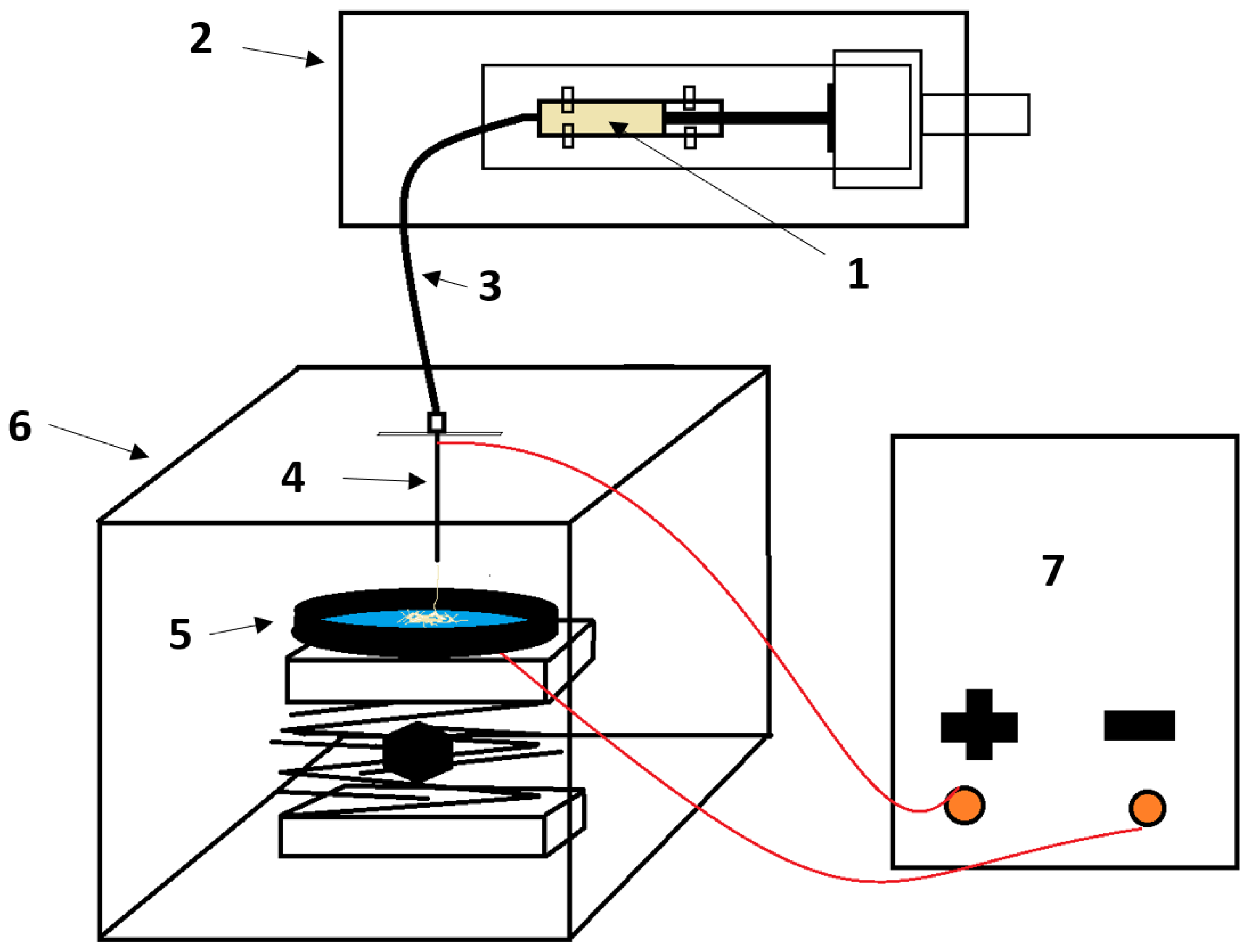
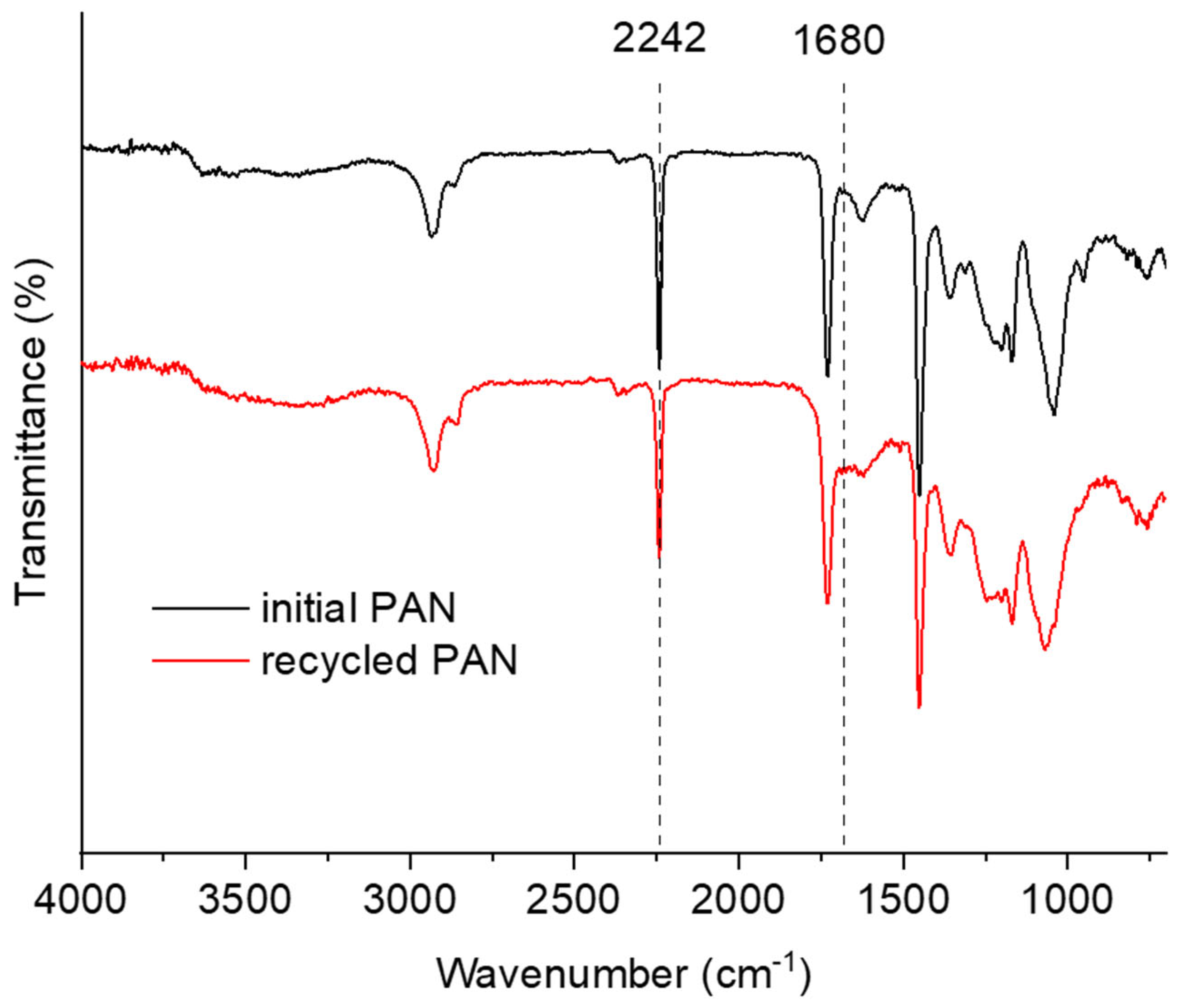
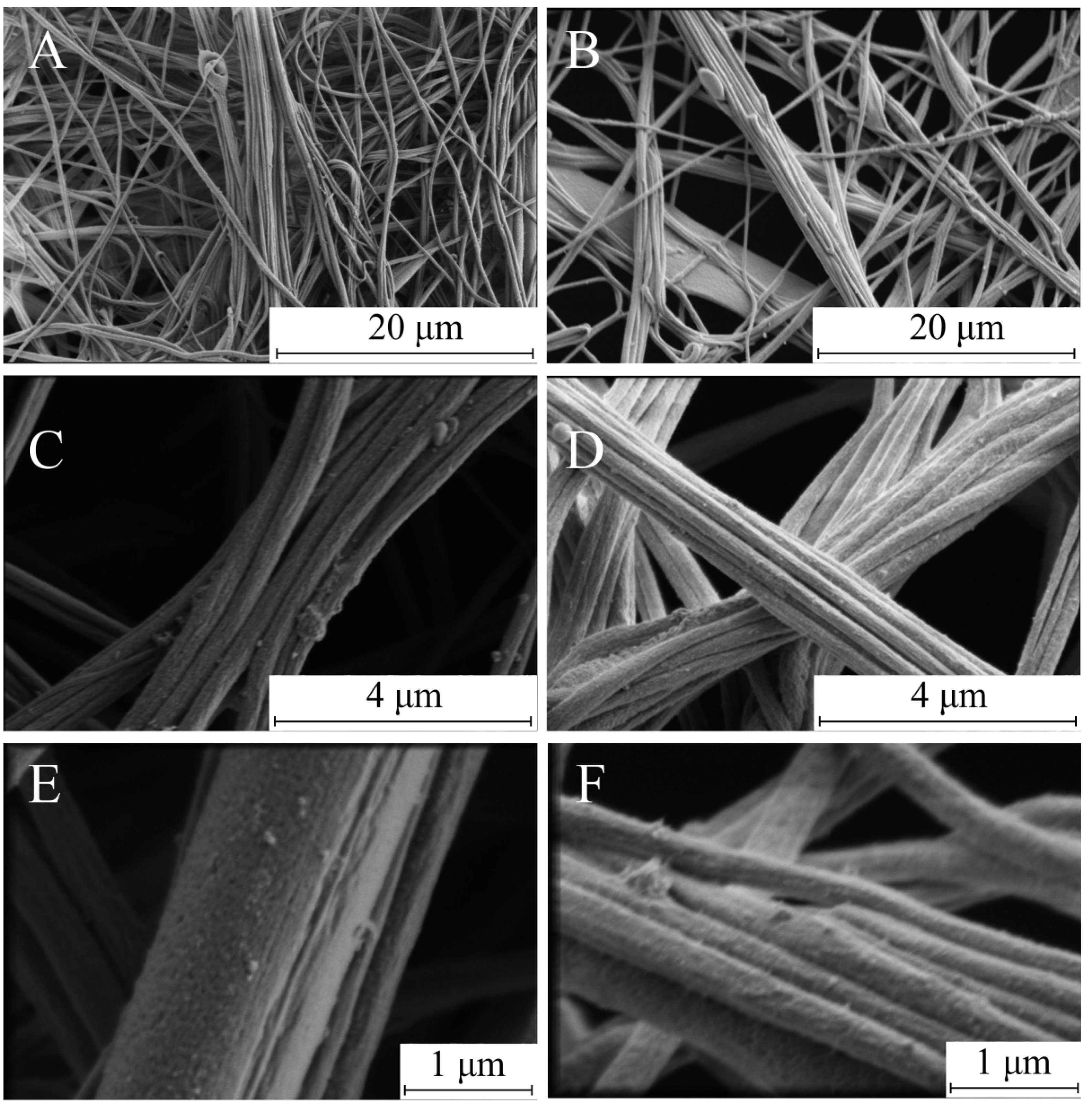
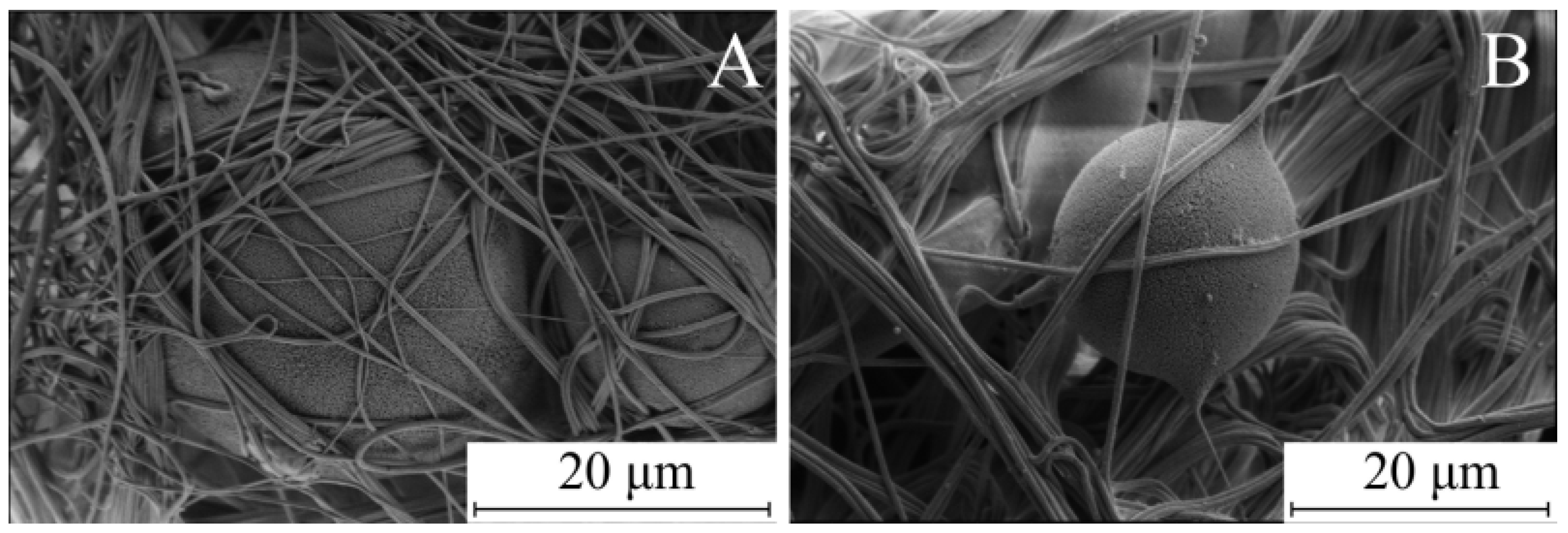
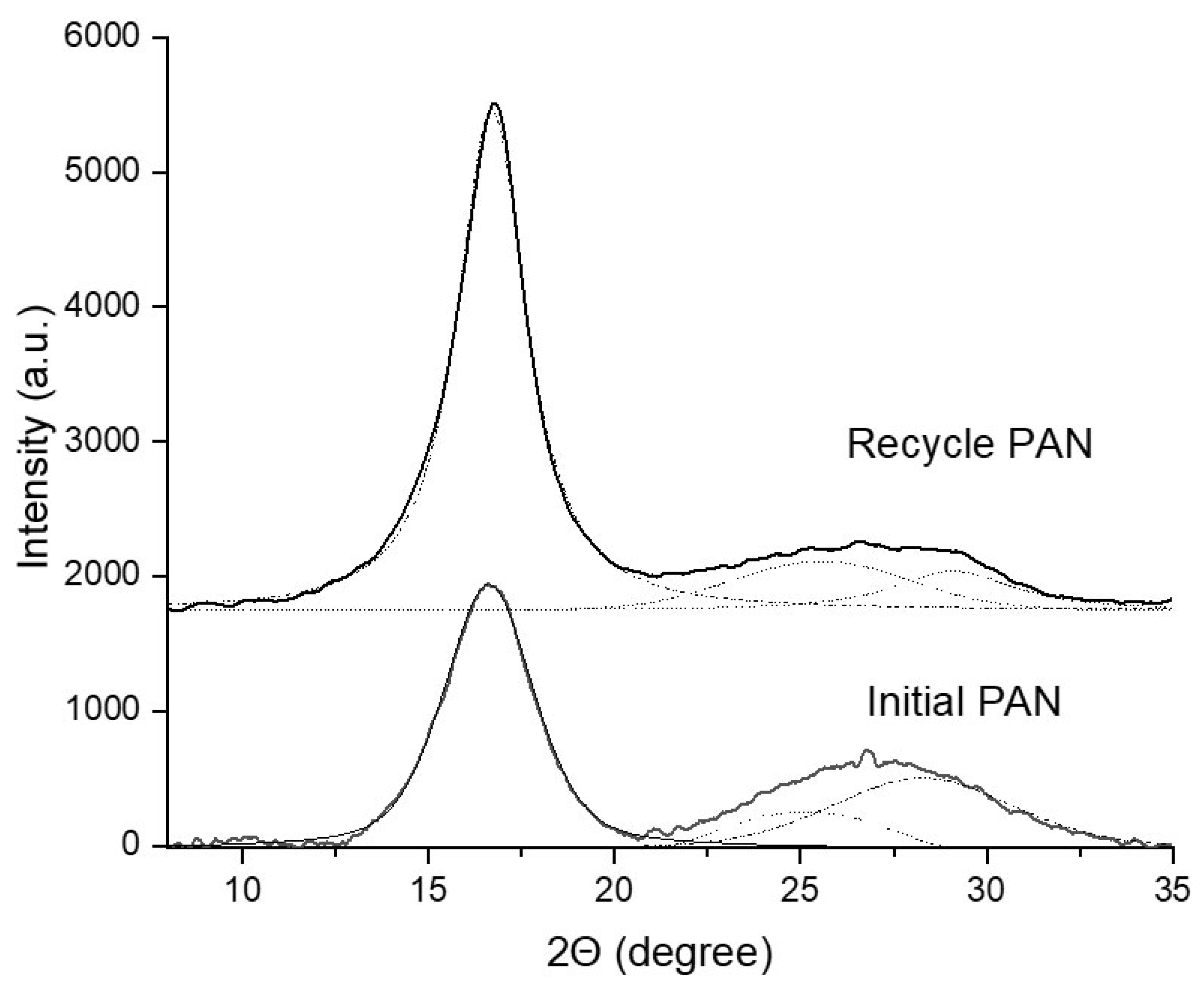
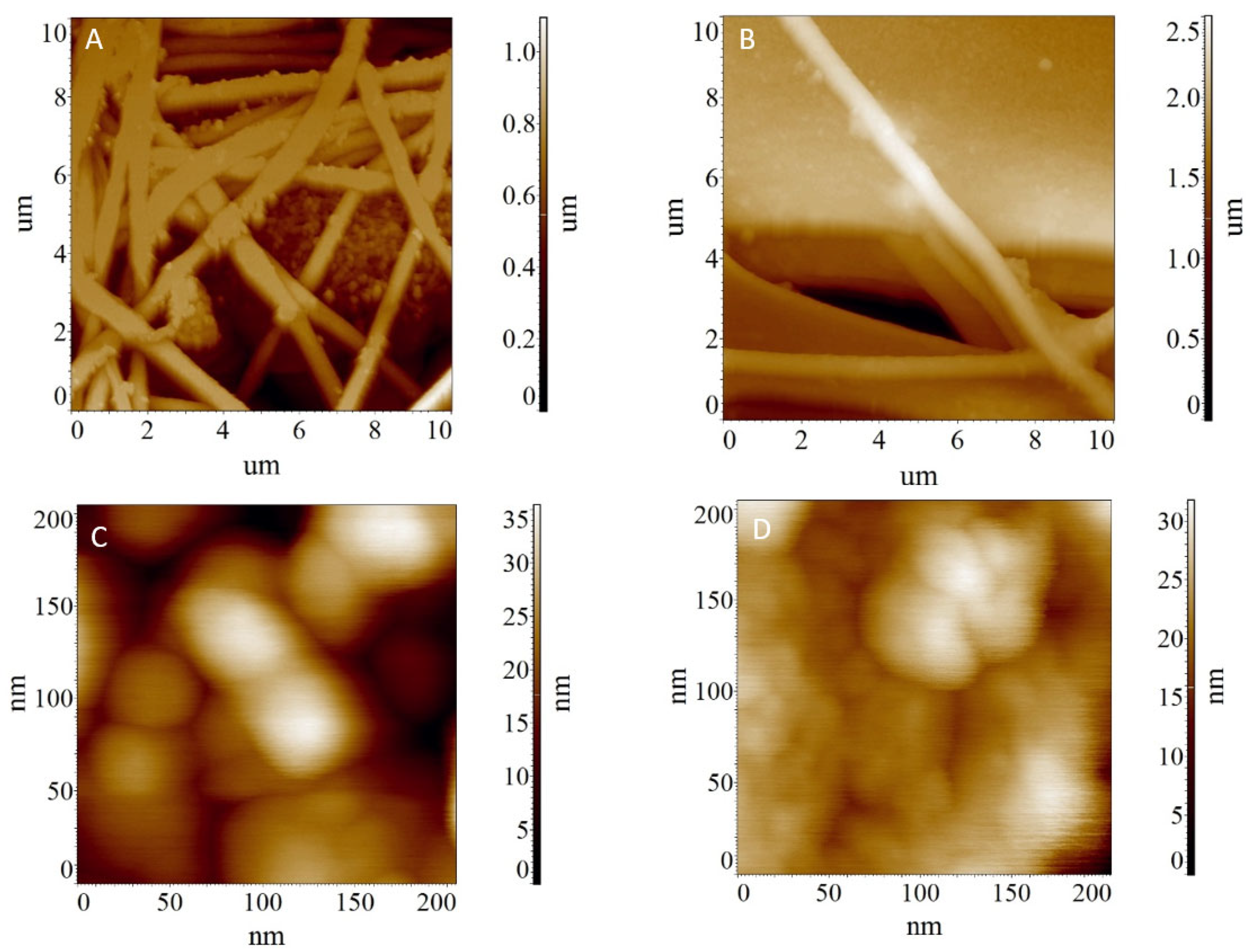
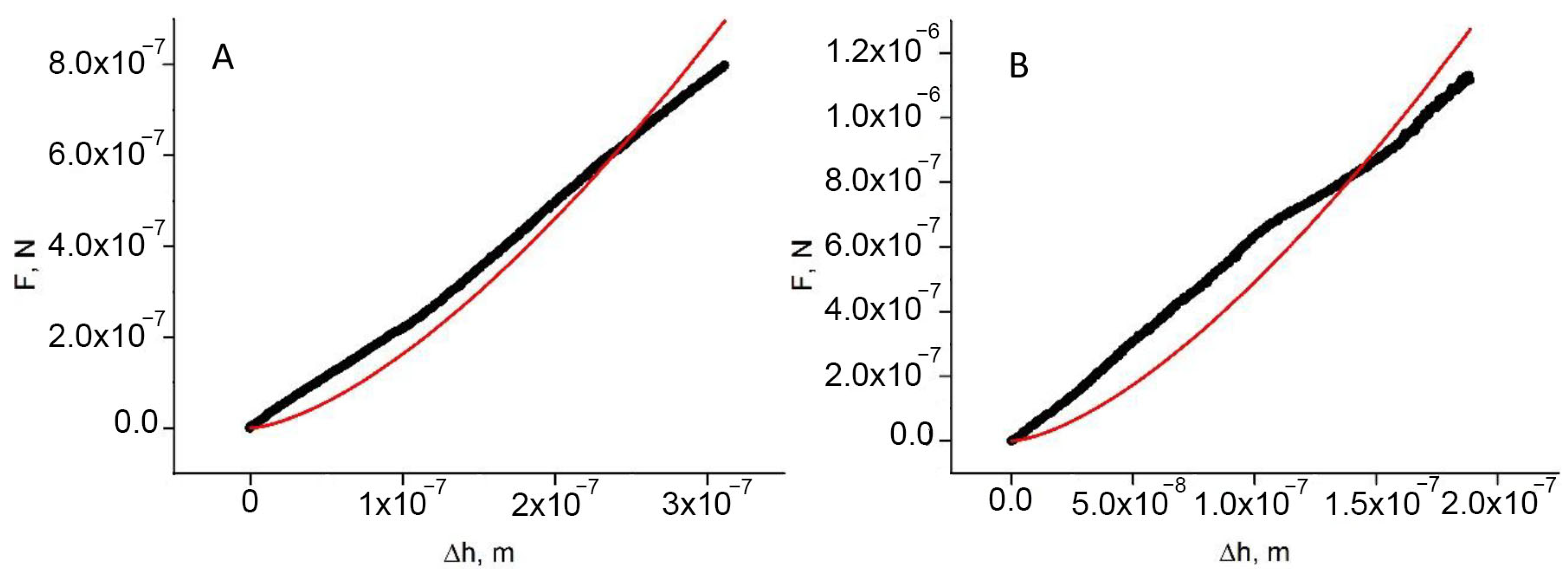
Disclaimer/Publisher’s Note: The statements, opinions and data contained in all publications are solely those of the individual author(s) and contributor(s) and not of MDPI and/or the editor(s). MDPI and/or the editor(s) disclaim responsibility for any injury to people or property resulting from any ideas, methods, instructions or products referred to in the content. |
© 2025 by the authors. Licensee MDPI, Basel, Switzerland. This article is an open access article distributed under the terms and conditions of the Creative Commons Attribution (CC BY) license (https://creativecommons.org/licenses/by/4.0/).
Share and Cite
Golubev, Y.V.; Makarov, I.S.; Karimov, D.N.; Arkharova, N.A.; Gainutdinov, R.V.; Legkov, S.A.; Kotomin, S.V. Recycling of PAN Waste into Nonwoven Materials Using Electrospinning Method. Fibers 2025, 13, 102. https://doi.org/10.3390/fib13080102
Golubev YV, Makarov IS, Karimov DN, Arkharova NA, Gainutdinov RV, Legkov SA, Kotomin SV. Recycling of PAN Waste into Nonwoven Materials Using Electrospinning Method. Fibers. 2025; 13(8):102. https://doi.org/10.3390/fib13080102
Chicago/Turabian StyleGolubev, Yaroslav V., Igor S. Makarov, Denis N. Karimov, Natalia A. Arkharova, Radmir V. Gainutdinov, Sergey A. Legkov, and Sergey V. Kotomin. 2025. "Recycling of PAN Waste into Nonwoven Materials Using Electrospinning Method" Fibers 13, no. 8: 102. https://doi.org/10.3390/fib13080102
APA StyleGolubev, Y. V., Makarov, I. S., Karimov, D. N., Arkharova, N. A., Gainutdinov, R. V., Legkov, S. A., & Kotomin, S. V. (2025). Recycling of PAN Waste into Nonwoven Materials Using Electrospinning Method. Fibers, 13(8), 102. https://doi.org/10.3390/fib13080102







